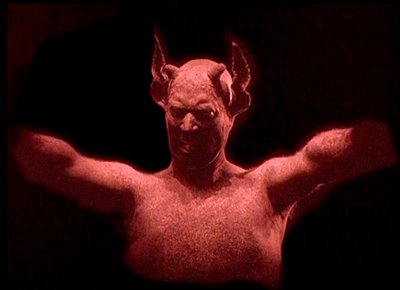Zoidberg, you handsome devil! WHOOP-oop-oop-oop-oop!
In case you’ve been dying to know what was the most expensive Scandinavian silent film ever made, your pangs are at an end: it was 1922’s Haxan. Haxan’s American title is Witchcraft Through the Ages, which is a distinct misnomer. A more accurate title would be A Comparison of Medieval Witch Hunts with Modern Psychological Studies of the Hysteric Temperament, but moviegoers would have stayed away in droves, I’m sure. They’d have missed a great show, though.
If you want something on the order of The Exorcist or The Blair Witch Project, this won’t suit you. Haxan is a docudrama, a study of the human imagination as it attempts to explain the existence of illness, crop failures, cows that don’t give milk, and pale young girls who steal things and/or fantasize about Entities bothering them. It was written and directed by Benjamin Christensen, who came across a copy of an ancient text on witchfinding called the Malleus Maleficarum and was inspired to film an examination of medieval superstitions. Christensen took three years to produce his film, and the effort he put into it shows. Not only are there meticulously recreated models based on old engravings, the historical sequences are lively and authentic. Christensen himself played the Devil and, in one bizarre cameo, Jesus, which makes you think he must have been an interesting person to know…
Haxan begins with a scholarly presentation on superstition and ancient models of the universe, complete with lecture-pointer in frame. After a charming little animated model of the medieval system is presented—Earth at the center, the crystal spheres with the planets, God and His angels massed like an Escher engraving outside it all— we get into the dramatized sequences about witchcraft.
While never veering from his argument that there were no real witches (as defined by the Church) and that all the fuss was due to superstition, Christiansen nevertheless has a lot of fun showing us the way people imagined witches operated. There are plenty of toothless crones in huts mixing disgusting brews in their cauldrons. The Devil prances around making faces and beckoning chaste wives into smooching him while their husbands sleep. There are several old woodcuts shown, one of which looks, I swear to you, like three witches having a solemn discussion over burgers and a Coke in a McDonald’s.
We get to see a reenactment of a witches’ sabbath, complete with several jolly leering lesser devils and one big devil in a papier-mâché head who clearly can’t see his worshippers very well. There is a spectacular (and horrible) animated model of Hell and its torments, with dozens of little animated devils stoking the fires. With all this, Haxan makes the point that morbid people imagined these things because their lives were dull, brutish and short, and because medieval Christians tended to obsess on fearing Satan rather than following Christ. Some women accused as witches were in reality herbalists; some were nasty old biddies who did indeed peddle useless charms and curses; some were just old, ugly and feeble-minded. Others were simply in the wrong place at the wrong time.
The next sequence is the closest thing to a straight narrative drama. In a medieval village, a young man lies dying of some illness, wept over by his wife and baby, his mother, and several elderly female servants. The wife declares that some witch must have put a spell on him. An ancient beggar-crone wanders into the kitchen and begs for food. The wife’s charitable impulse to let the old thing have some soup quickly curdles as she realizes this must be the witch! Fortunately the Inquisition (what a show) is staying in town, so the young wife runs right off and tells a handsome young Inquisitor, who is clearly aroused by her clinging to his arm. An older Inquisitor quickly takes charge, however, and send his goons off to drag away the old crone.
The Inquisitors aren’t merely there to punish; they want to root out all witches! They torture the old woman without results, until they demand the names of all the other witches in the village. The old woman promptly accuses all sorts of people who have been nasty to her, including the dying man’s mother and servants. Away go the goons to drag these innocent ladies to torture, leaving the young wife and her baby alone. As Christensen points out, you can’t beat the logic of the Inquisition. To be accused is to be guilty, and torture will prove it. If you disagree with the Inquisitors, you must be in league with the Devil yourself, so the goons come for you next. The village is decimated, most of its women burned at the stake, before the Inquisitors load up the torture gear into their wagons and move on to the next village. Christensen somberly adds that 8 million men, women and children were burned as witches by the Inquisition.
The final sequences deal with the contrast between the ways mental illness was perceived in medieval times and how, in the enlightened early years of the 20th century, delusional people were diagnosed and treated instead. It leaves you with a wistful longing for those days when people assumed Science had swept the world clean of superstition and rank unreason, when people knew torture was useless barbarism and no devil was hiding under your bed…
Haxan has been particularly well served by the Criterion Collection DVD release. Not only is the print crystal-clear and splendidly restored, there are loads of extras, most notably the 1968 American edited version with commentary by William S. Burroughs (!) narrating and a special jazz score featuring Jean-Luc Ponty, among others. This was the version shown at college midnight matinees, and when bong-enhanced made for surreal viewing indeed. Family entertainment it ain’t, though, so wait until your kids have gone to bed before you slip Haxan into the DVD player.










